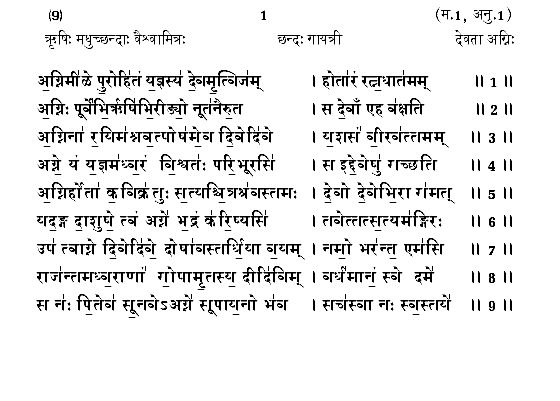Allgemein
Sanskrit-Literatur
Hans Zimmermann - hanumans@t-online.de
Altindische Texte sind in vedischem Sanskrit, also in einer
indogermanischen Sprache verfaßt, die zwar nicht so früh
bezeugt ist wie z.B. das Hethitische, die aber mit den etwas jüngeren
europäischen Altsprachen Griechisch und Latein eine geradezu
verblüffende Verwandtschaft in Lexik und Morphologie, ja
sogar in der quantitierenden Metrik zeigt. Mit dem
Griechischen hat sie auch die literarische Fülle der Texte
und die Geburt der Philosophie, der metrischen Dichtung, des
Dramas und der wissenschaftlichen Systematik gemein.
http://home.t-online.de/home/hanumans/home2.htm
Sacred
Texts: Hinduism
J.B. Hare - postmaster@sacred-texts.com
There are four Vedas,
the Rig Veda, Sama Veda, Yajur Veda and Atharva Veda. The
Vedas are the primary texts of Hinduism. They also had a vast
influence on Buddhism, Jainism, and Sikhism. The Rig Veda, the
oldest of the four Vedas, was composed about 1500 B.C., and
written down about 600 B.C.
The Vedas
contain hymns, incantations, and rituals from ancient India.
Along with the
Book of the Dead, the Enuma
Elish, the I
Ching, and the Avesta,
they are among the most ancient religious texts still in
existence. Besides their spiritual value, they also give a
unique view of everyday life in India four thousand years ago.
The Vedas are also the most ancient extensive texts in an
Indo-European language, and as such are invaluable in the
study of comparative linguistics.
The Upanishads
are a continuation of the Vedic philosophy, and were written
between 800 and 400 B.C. They elaborate on how the soul (Atman)
can be united with the ultimate truth (Brahman) through
contemplation and mediation, as well as the doctrine of Karma--
the cumulative effects of a persons' actions.
The Bhagavad
Gita, usually included as the sixth book of the Mahabharata
(dating from about 400 or 300 B.C.), is a central text of
Hinduism, a philosphical dialog between the god Krishna and
the warrior Arjuna. This is one of the most popular of all
Hindu scriptures. The Gita discusses selflessness, duty,
devotion, and meditation, integrating many different threads
of Hindu philosophy.
The Ramayana,
attributed to the poet Valmiki, was written down during the
first century A.D., although it is based on oral traditions
that go back six or seven centuries earlier. The Ramayana is a
moving love story with moral and spiritual themes that has
deep appeal in India to this day.
http://www.sacred-texts.com/hin/index.htm
Devanagari
(Hindi) Fonts
Viele Links zu Devanagari-Fonts.
http://www.cs.colostate.edu/~malaiya/devafonts.htm
|




